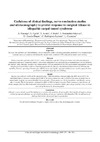Please use this identifier to cite or link to this item:
https://accedacris.ulpgc.es/jspui/handle/10553/50123
| DC Field | Value | Language |
|---|---|---|
| dc.contributor.author | Naranjo, Antonio | en_US |
| dc.contributor.author | Ojeda, Soledad | en_US |
| dc.contributor.author | Araña, Virginia | en_US |
| dc.contributor.author | Baeta, Pilar | en_US |
| dc.contributor.author | Fernández-Palacios, Javier | en_US |
| dc.contributor.author | García-Duque, Orlando | en_US |
| dc.contributor.author | Rodríguez-Lozano, Carlos | en_US |
| dc.contributor.author | Carmona, Loreto | en_US |
| dc.contributor.other | Carmona, Loreto | - |
| dc.contributor.other | Naranjo Hernandez, Antonio | - |
| dc.date.accessioned | 2018-11-24T13:29:59Z | - |
| dc.date.available | 2018-11-24T13:29:59Z | - |
| dc.date.issued | 2009 | en_US |
| dc.identifier.issn | 0392-856X | en_US |
| dc.identifier.uri | https://accedacris.ulpgc.es/handle/10553/50123 | - |
| dc.description.abstract | OBJECTIVES: To assess the usefulness of clinical findings, nerve conduction studies and ultrasonography performed by a rheumatologist to predict success in patients with idiopathic carpal tunnel syndrome (CTS) undergoing median nerve release. METHODS: Ninety consecutive patients with CTS (112 wrists) completed a specific CTS questionnaire and underwent physical examination and nerve conduction studies. Ultrasound examination was performed by a rheumatologist who was blind to any patient's data. Outcome variables were improvement >25% in symptoms of the CTS questionnaire and patient's overall satisfaction (5-point Likert scale) at 3 months postoperatively. Success was defined as improvement in both outcome variables. Receiver operating characteristics (ROC) curves and logistic regression analyses were used to assess the best predictive combination of preoperative findings. RESULTS: Success was achieved in 63% of the operated wrists. Utility parameters and area under the ROC curve (AUC) for individual findings was poor, ranging from 0.481 of the nerve conduction study to 0.634 of the cross-sectional area at tunnel outlet. Logistic regression identified the preoperative US parameters as the best predictive variables for success after 3 months. The best predictive combination (AUC=0.708) included a negative Phalen maneuver, plus absence of thenar atrophy, plus less than moderately abnormalities on nerve conduction studies plus a large maximal cross-sectional area along the tunnel by ultrasonography. CONCLUSION: Although cross-sectional area of the median nerve was the only predictor of success after three months of surgical release, isolated preoperative findings are not reliable predictors of success in patients with idiopathic CTS. A combination of findings that include ultrasound improves prediction. | en_US |
| dc.language | eng | en_US |
| dc.relation.ispartof | Clinical and Experimental Rheumatology | en_US |
| dc.source | Clinical and Experimental Rheumatology [ISSN 0392-856X], v. 27 (5), p. 786-793, (2009) | en_US |
| dc.subject | 32 Ciencias médicas | en_US |
| dc.subject.other | Carpal tunnel | en_US |
| dc.subject.other | Neurophisiology | en_US |
| dc.subject.other | Ultrasonography | en_US |
| dc.title | Usefulness of clinical findings, nerve conduction studies and ultrasonography to predict response to surgical release in idiopathic carpal tunnel syndrome | en_US |
| dc.type | info:eu-repo/semantics/article | en_US |
| dc.type | Article | en_US |
| dc.identifier.scopus | 72949102607 | - |
| dc.identifier.isi | 000272278400145 | - |
| dcterms.isPartOf | Clinical And Experimental Rheumatology | - |
| dcterms.source | Clinical And Experimental Rheumatology[ISSN 0392-856X],v. 27 (5), p. 786-793 | - |
| dc.contributor.authorscopusid | 7003297397 | - |
| dc.contributor.authorscopusid | 8654250900 | - |
| dc.contributor.authorscopusid | 35247700700 | - |
| dc.contributor.authorscopusid | 35797895200 | - |
| dc.contributor.authorscopusid | 6603739967 | - |
| dc.contributor.authorscopusid | 6505901527 | - |
| dc.contributor.authorscopusid | 6603136298 | - |
| dc.contributor.authorscopusid | 35263586300 | - |
| dc.identifier.crisid | 2880;-;-;-;-;-;-;- | - |
| dc.description.lastpage | 793 | en_US |
| dc.description.firstpage | 786 | en_US |
| dc.relation.volume | 27 | en_US |
| dc.investigacion | Ciencias de la Salud | en_US |
| dc.rights.accessrights | info:eu-repo/semantics/openAccess | - |
| dc.type2 | Artículo | en_US |
| dc.identifier.wos | WOS:000272278400145 | - |
| dc.contributor.daisngid | 550893 | - |
| dc.contributor.daisngid | 343824 | - |
| dc.contributor.daisngid | 2694423 | - |
| dc.contributor.daisngid | 13312352 | - |
| dc.contributor.daisngid | 4703840 | - |
| dc.contributor.daisngid | 9155723 | - |
| dc.contributor.daisngid | 1048977 | - |
| dc.contributor.daisngid | 33330 | - |
| dc.identifier.investigatorRID | A-2748-2014 | - |
| dc.identifier.investigatorRID | E-7910-2010 | - |
| dc.utils.revision | Sí | en_US |
| dc.identifier.supplement | 2880;-;-;-;-;-;-;- | - |
| dc.identifier.supplement | 2880;-;-;-;-;-;-;- | - |
| dc.identifier.ulpgc | Sí | en_US |
| dc.contributor.buulpgc | BU-MED | en_US |
| dc.description.jcr | 2,396 | - |
| dc.description.jcrq | Q3 | - |
| dc.description.scie | SCIE | - |
| item.fulltext | Con texto completo | - |
| item.grantfulltext | open | - |
| crisitem.author.dept | GIR IUIBS: Grupo de investigaciones infecciosas, nutricionales e inflamatorias en pacientes hospitalarios | - |
| crisitem.author.dept | IU de Investigaciones Biomédicas y Sanitarias | - |
| crisitem.author.dept | Departamento de Ciencias Médicas y Quirúrgicas | - |
| crisitem.author.dept | GIR IDeTIC: División de Ingeniería de Comunicaciones | - |
| crisitem.author.dept | IU para el Desarrollo Tecnológico y la Innovación | - |
| crisitem.author.dept | Departamento de Señales y Comunicaciones | - |
| crisitem.author.orcid | 0000-0002-2013-6664 | - |
| crisitem.author.orcid | 0000-0002-5919-9224 | - |
| crisitem.author.parentorg | IU de Investigaciones Biomédicas y Sanitarias | - |
| crisitem.author.parentorg | IU para el Desarrollo Tecnológico y la Innovación | - |
| crisitem.author.fullName | Naranjo Hernández, Antonio | - |
| crisitem.author.fullName | Araña Pulido, Víctor Alexis | - |
| Appears in Collections: | Artículos | |
SCOPUSTM
Citations
30
checked on Jun 8, 2025
WEB OF SCIENCETM
Citations
28
checked on Feb 25, 2024
Page view(s)
166
checked on Sep 23, 2024
Download(s)
69
checked on Sep 23, 2024
Google ScholarTM
Check
Share
Export metadata
Items in accedaCRIS are protected by copyright, with all rights reserved, unless otherwise indicated.
